
The Endocrine System

Endocrine System: Overview
•
Endocrine system – the body’s second great
controlling system which influences metabolic
ac;vi;es of cells by means of hormones
•
Endocrine glands – pituitary, thyroid,
parathyroid, adrenal, pineal, and thymus
•
The pancreas and gonads produce both
hormones and exocrine products

Endocrine System: Overview
•
The hypothalamus has both neural func;ons
and releases hormones
•
Other ;ssues and organs that produce
hormones – adipose cells, pockets of cells in
the walls of the small intes;ne, stomach,
kidneys, and heart
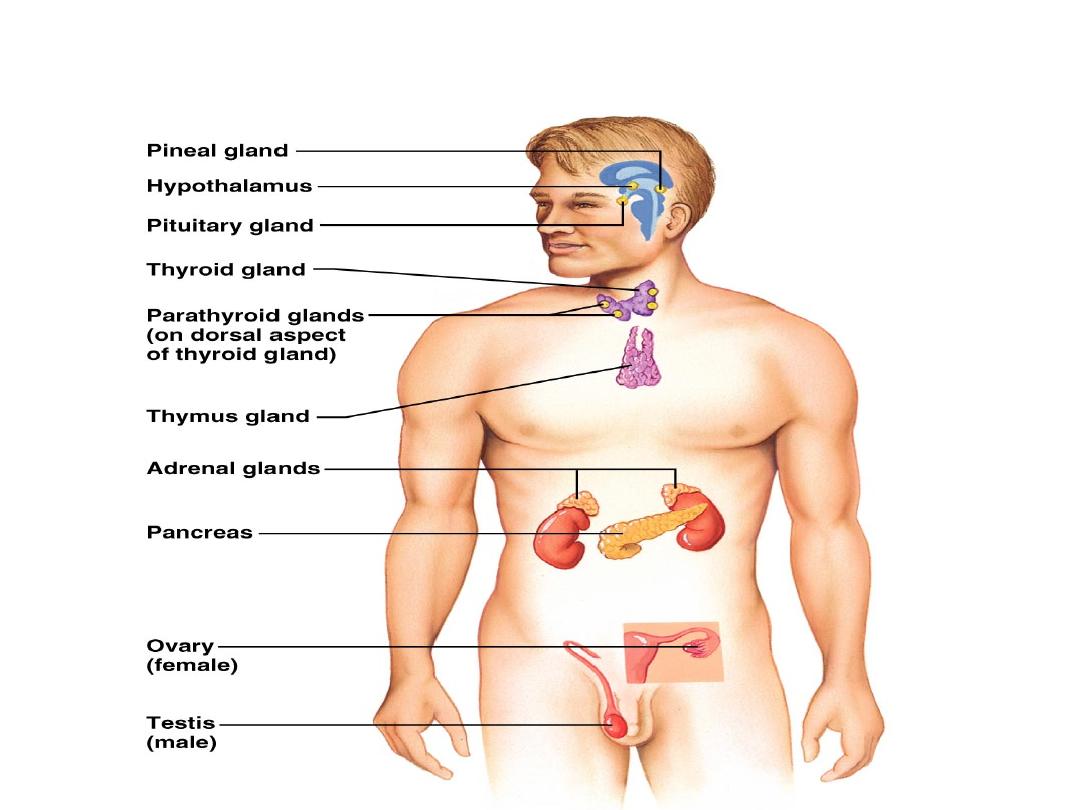
Major Endocrine Organs

Intercellular communica;on
•
Direct communica4on
–
Through gap junc;ons
–
Ions, small solutes, etc
–
Limited to adjacent cells of the same type
•
Synap4c communica4on
–
NeurotransmiGers
–
Used in crises management

Intercellular communica;on
•
Autocrine
–
chemicals that exert effects on the same cells that
secrete them
•
Paracrine
–
locally ac;ng chemicals that affect cells other
than those that secrete them
•
Cytokines or local hormones
•
These are not considered hormones since hormones
are long-‐distance chemical signals

Intercellular communica;on
•
Endocrine
–
Hormones – chemical substances secreted by cells
into the extracellular fluids
•
Regulate the metabolic func;on of other cells
•
Have lag ;mes ranging from seconds to hours
•
Tend to have prolonged effects

Types of Hormones
•
Amino acid based
–
Amines,
–
Thyroxine,
–
ADH
–
Oxytocin
–
GH
–
Prolac;n

Types of Hormones
•
Lipid deriva4ves
–
Steroids
– gonadal and adrenocor;cal hormones
–
Eicosanoids
– leukotrienes and prostaglandins
•
Func;on as paracrine and autocrine factors
•
Func;on as hormones

Hormone Ac;on
•
Hormones that bind to receptors in the cell
membrane:
–
First and second messengers
–
Regulatory G proteins
–
Water-‐soluble hormones
•
Hormones that bind to intracellular receptors
–
Direct gene ac;va;on
–
Steroid and thyroid hormones
•
The precise response depends on the type of the target
cell

Mechanism of Hormone Ac;on
•
Hormones produce one or more of the
following cellular changes in target cells
–
Alter plasma membrane permeability
–
S;mulate protein synthesis
–
Ac;vate or deac;vate enzyme systems
–
Induce secretory ac;vity
–
S;mulate mitosis

Hormones that bind to receptors in the cell
membrane: cAMP mechanism
•
Hormone (first messenger) binds to its
receptor, which then binds to a G protein
•
The G protein is then ac;vated as it binds GTP,
displacing GDP
•
Ac;vated G protein ac;vates the enzyme
adenylate cyclase
•
Adenylate cyclase generates cAMP (second
messenger) from ATP
•
cAMP ac;vates protein kinases, which then
cause cellular effects
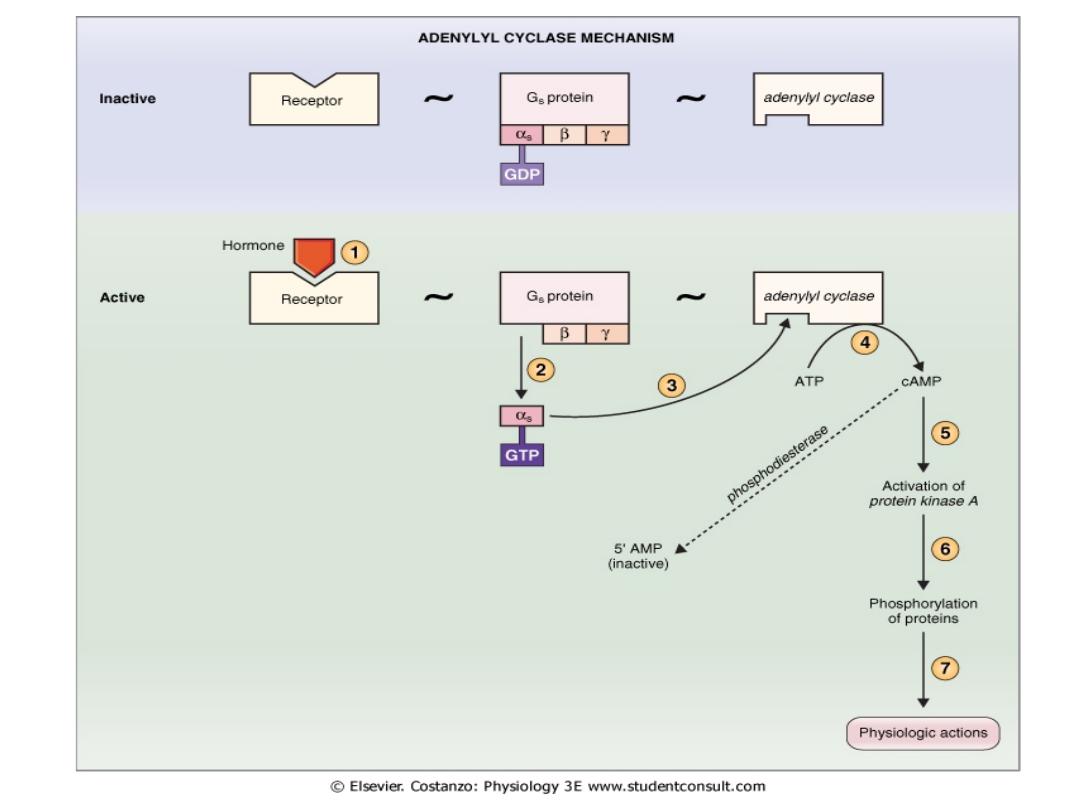
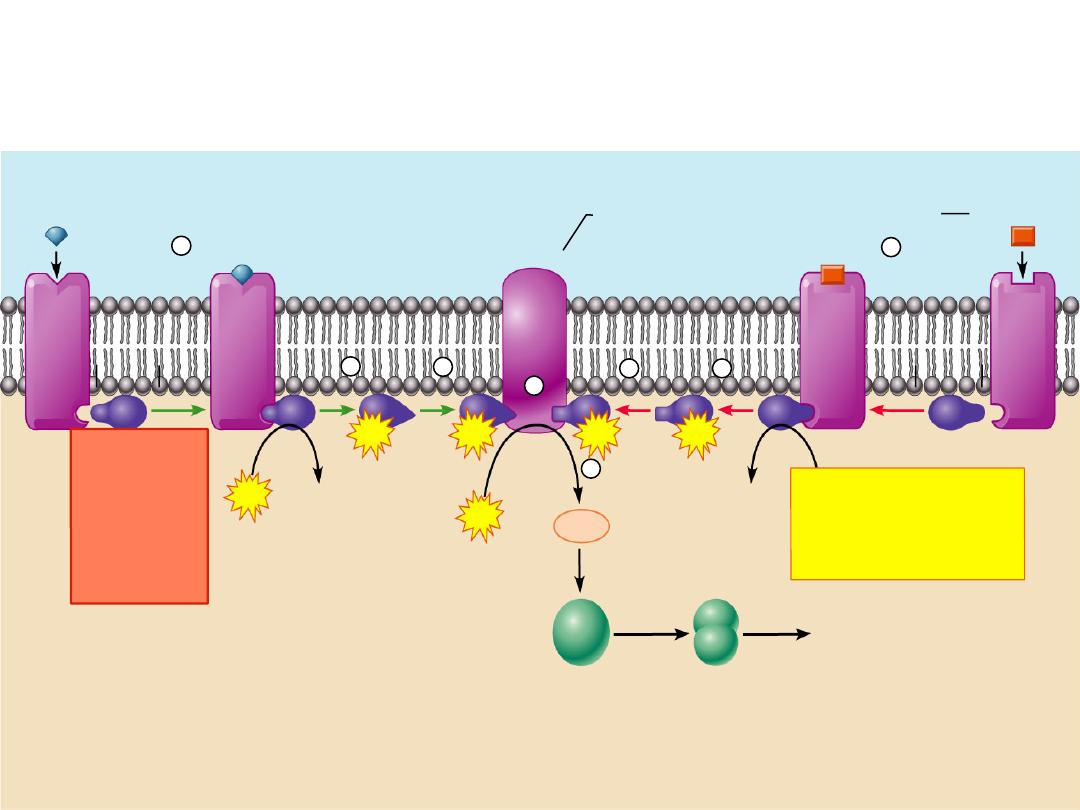
14
Receptor
Hormone A
Receptor
GTP
GTP
GTP
GTP
GTP
GTP
ATP
cAMP
Inactive
protein
kinase A
Active
protein
kinase A
Catecholamines
ACTH
FSH
LH
Glucagon
PTH
TSH
Calcitonin
Triggers responses of target
cell (activates enzymes,
stimulates cellular
secretion, opens ion
channels, etc.)
Adenylate cyclase
Hormone B
GDP
GDP
Extracellular fluid
Cytoplasm
G
s
G
i
1
2
3
4
3
2
1
5
Hormones that bind to receptors in the cell
membrane : cAMP mechanism

Hormones that bind to receptors in the cell
membrane: PIP-‐Calcium mechanism
•
Hormone binds to the receptor and ac;vates
G protein
•
G protein binds and ac;vates phospholipase
•
Phospholipase splits the phospholipid PIP
2
into
diacylglycerol (DAG) and IP
3
(both act as second
messengers)
•
DAG ac;vates protein kinases; IP
3
triggers
release of Ca
2+
stores
•
Ca
2+
(second messenger) alters cellular
responses
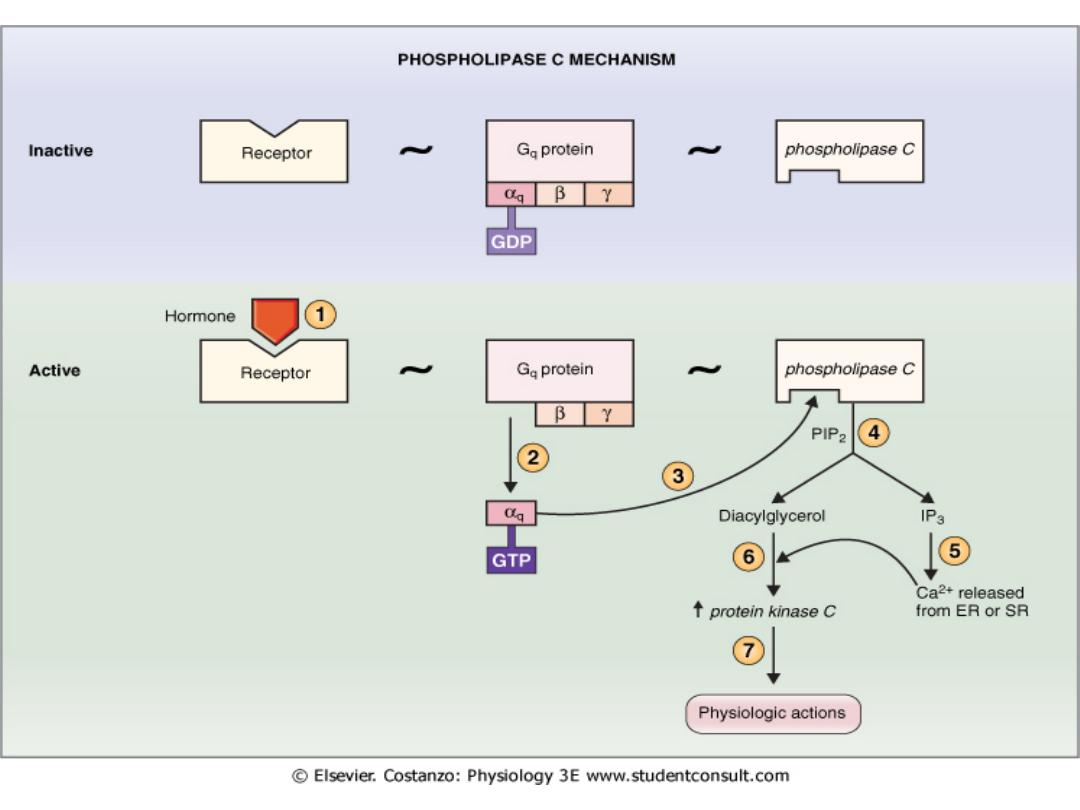
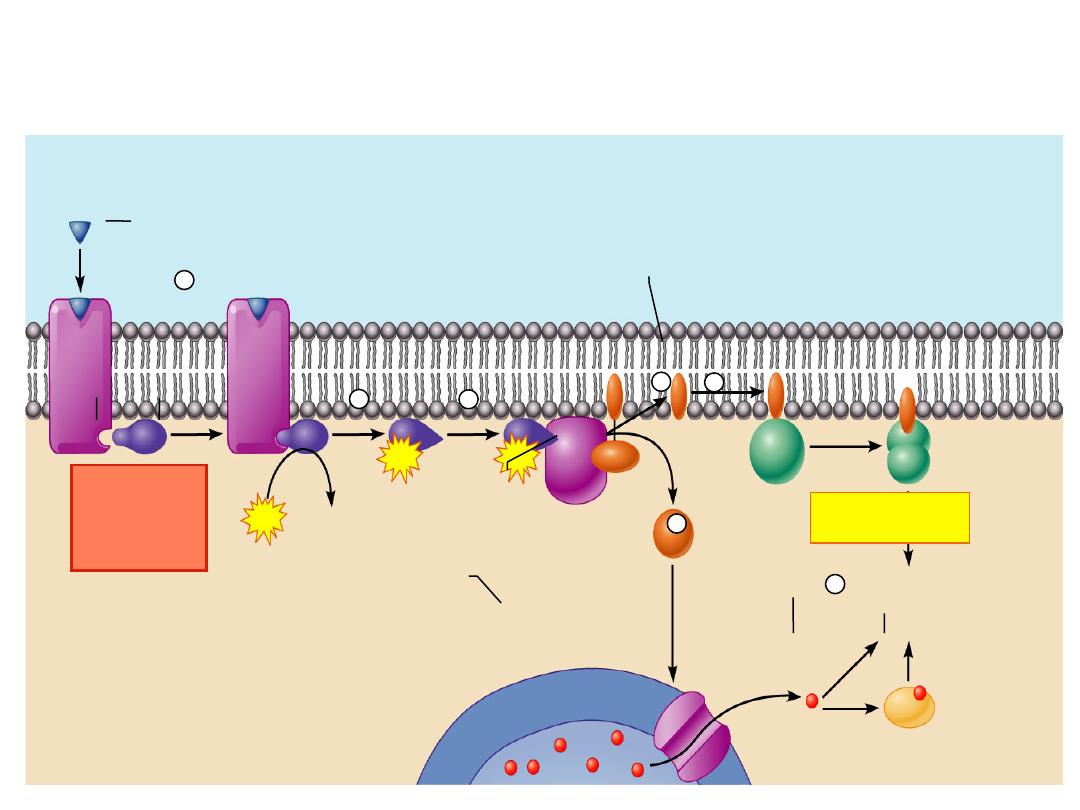
GTP
PIP
2
IP
3
Receptor
GTP
GTP
Catecholamines
TRH
ADH
GnRH
Oxytocin
Triggers responses
of target cell
GDP
Extracellular fluid
Cytoplasm
Inactive
protein
kinase C
Active
protein
kinase C
Phospholipase C
G
q
Ca
2+
Ca
2+
- calmodulin
Hormone
Endoplasmic
reticulum
DAG
1
2
3
4
5
5
6
Hormones that bind to receptors in the cell membrane: PIP-
Calcium mechanism
Catecholamines (α
1
receptors)
TRH
ADH
GnRH
Oxytocin

Hormones that bind to intracellular
receptors
•
Steroid Hormones
–
This interac;on prompts DNA transcrip;on to
produce mRNA
–
The mRNA is translated into proteins, which bring
about a cellular effect
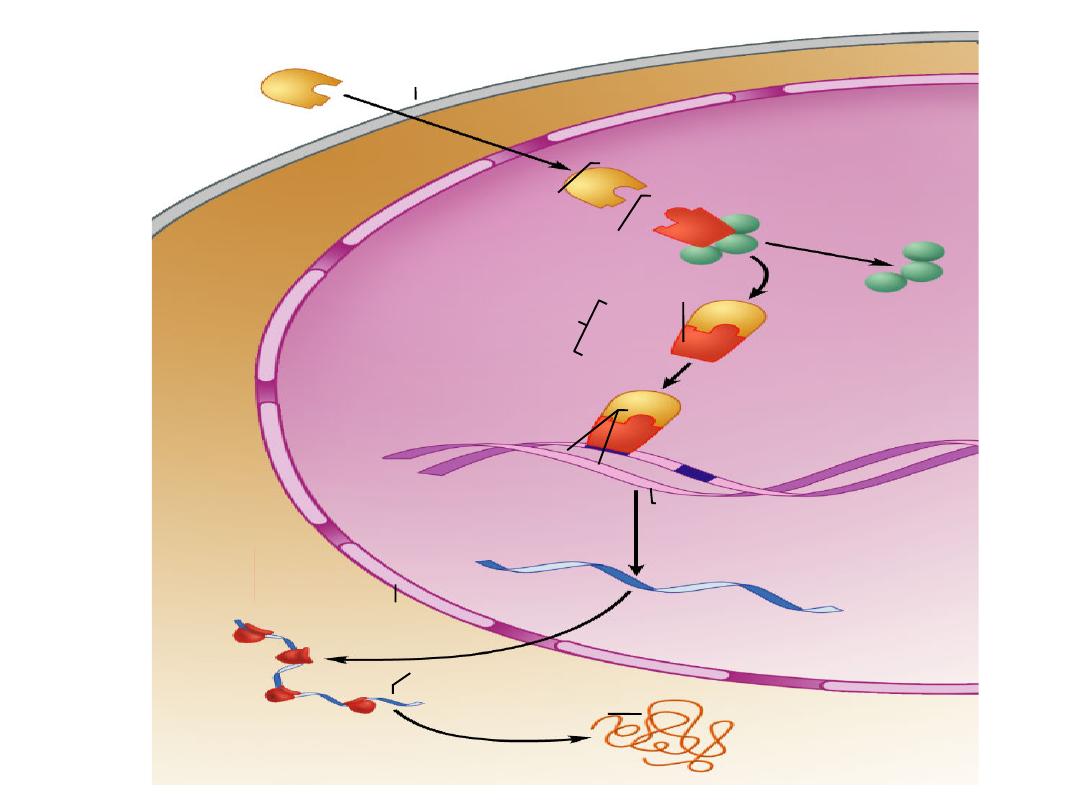
Steroid
hormone
Steroid
hormone
Cytoplasm
Receptor-
chaperonin
complex
Molecular
chaperones
Receptor-hormone
complex
Hormone
response
elements
Binding
Transcription
Chromatin
mRNA
Nucleus
New protein
Translation
Ribosome
mRNA

Target Cell Specificity
•
Hormones circulate to all ;ssues but only
ac;vate cells referred to as target cells
•
Target cells must have specific receptors to
which the hormone binds
•
These receptors may be intracellular or
located on the plasma membrane

Target Cell Specificity
•
Examples of hormone ac;vity
–
ACTH receptors are only found on certain cells of
the adrenal cortex
–
Thyroxin receptors are found on nearly all cells of
the body

Target Cell Ac;va;on
•
Target cell ac;va;on depends on three factors
–
Blood levels of the hormone
–
Rela;ve number of receptors on the target cell
–
The affinity of those receptors for the hormone

Target Cell Ac;va;on
•
Up-‐regula;on – when a hormone causes the
target cells to form more receptors to it. It
causes the ;ssue to become more sensi;ve to
the hormone.
•
Down-‐regula;on – when a hormone cause the
target cells to lose receptors to it. It causes
the ;ssue to become less sensi;ve to the
specific hormone

Hormone Concentra;ons in the Blood
•
Hormones circulate in the blood in two forms:
free or bound.
–
Bound:
•
AGached to plasma proteins
•
Bound to their own carriers

Hormone Concentra;ons in the Blood
•
Concentra;ons of circula;ng hormone reflect:
–
Rate of release
–
Speed of inac;va;on and removal from the body
•
Hormones are removed from the blood by:
–
Degrading enzymes
–
The kidneys
–
Liver enzyme systems

Interac;on of Hormones at Target
Cells
Permissiveness
– one hormone cannot exert its effects
without another hormone being present.
–
Estrogen and thyroid hormone
•
Synergism
– more than one hormone produces the
same effects on a target cell
–
Glucagon and epinephrine
•
Antagonism
– one or more hormones opposes the
ac;on of another hormone.
–
Glucagon and insulin

Control of Hormone Release
•
Blood levels
of hormones:
–
Are controlled by nega;ve feedback systems
–
Vary only within a narrow desirable range
•
Hormones are synthesized and released
by
glands
in response to:
–
Humoral s;muli
–
Neural s;muli
–
Hormonal s;muli

Humoral S;muli
•
Humoral s;muli – secre;on of hormones in direct
response to changing blood levels of ions and
nutrients
•
Example: concentra;on of calcium ions in the blood
–
Declining blood Ca
2+
concentra;on s;mulates the
parathyroid glands to secrete PTH (parathyroid
hormone)
–
PTH causes Ca
2+
concentra;ons to rise and the
s;mulus is removed
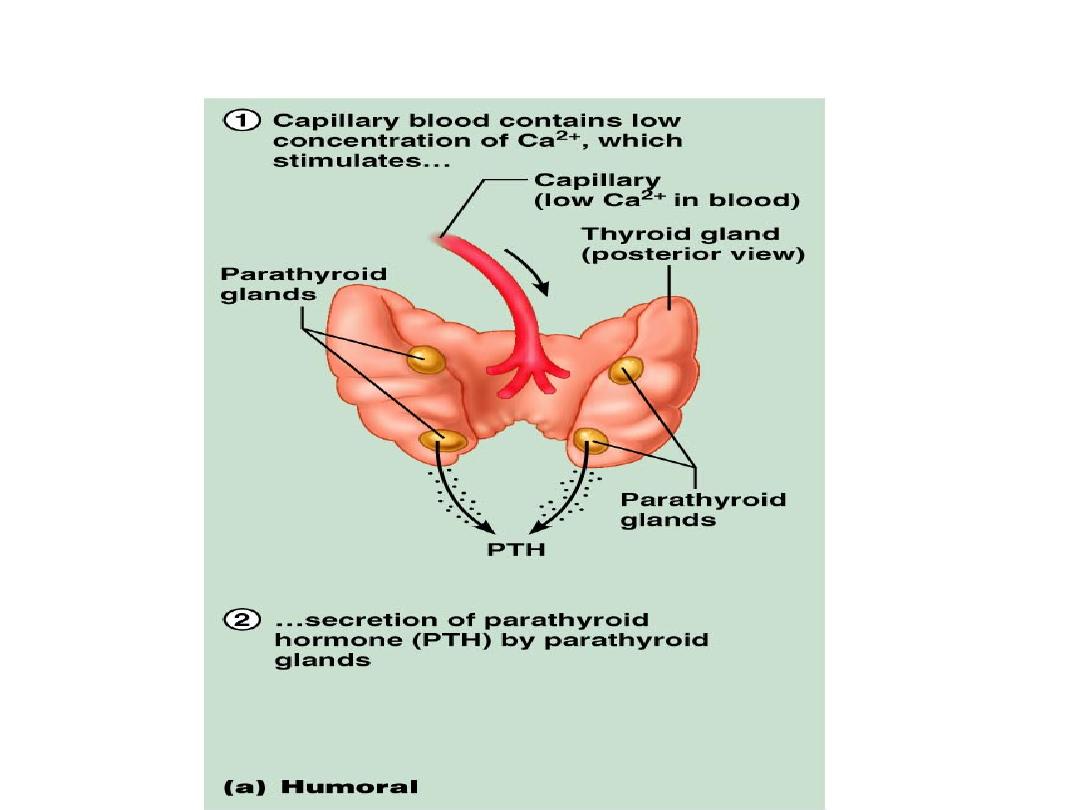
Humoral
S;muli
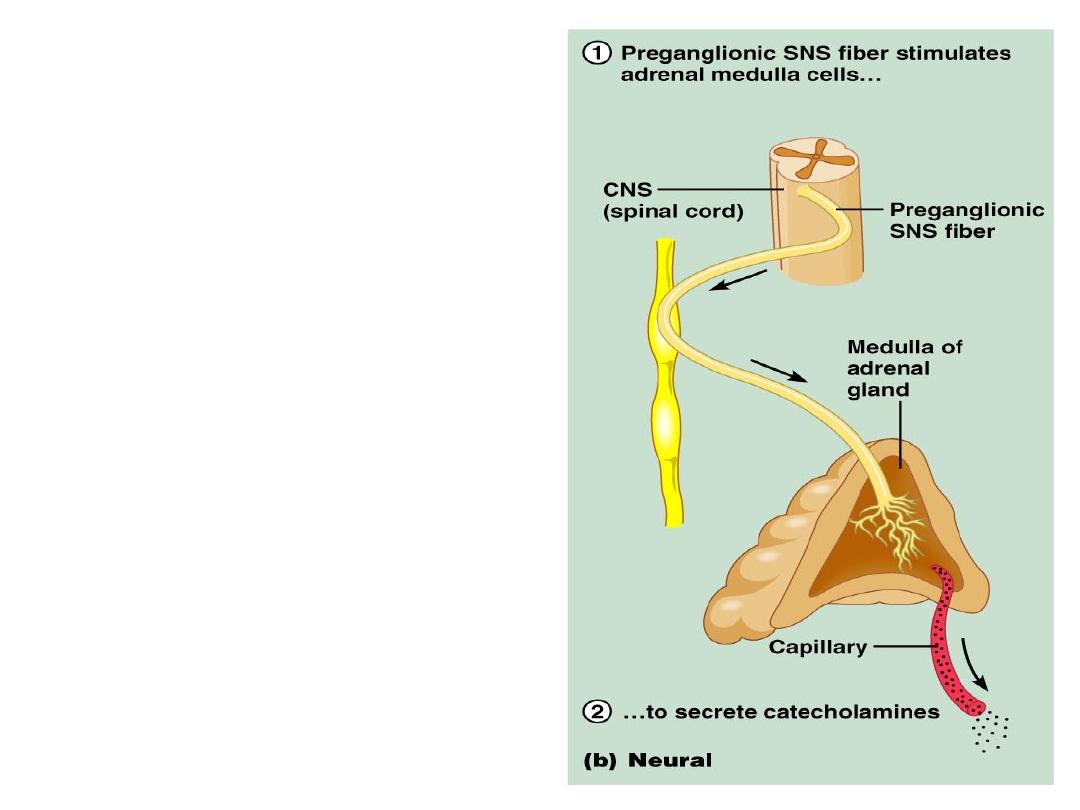
Neural S;muli
•
Neural s;muli – nerve
fibers s;mulate
hormone release
–
Preganglionic
sympathe;c nervous
system (SNS) fibers
s;mulate the adrenal
medulla to secrete
catecholamines

Hormonal S;muli
•
Hormonal s;muli – release of hormones in response
to hormones produced by other endocrine organs
–
The hypothalamic hormones s;mulate the
anterior pituitary
–
In turn, pituitary hormones s;mulate targets to
secrete s;ll more hormones
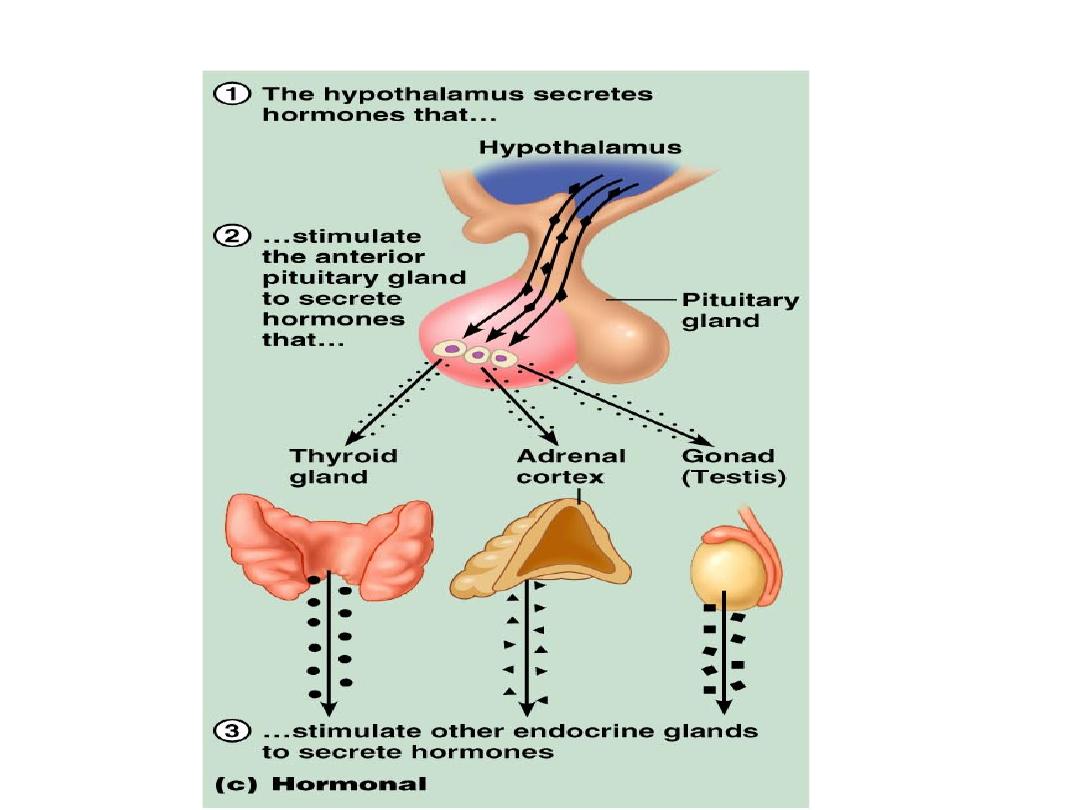
Hormonal
S;muli

Nervous System Modula;on
•
The nervous system modifies the s;mula;on
of endocrine glands and their nega;ve
feedback mechanisms

Nervous System Modula;on
•
The nervous system can override normal endocrine
controls
–
For example, control of blood glucose levels
•
Normally the endocrine system maintains blood
glucose
•
Under stress, the body needs more glucose
•
The hypothalamus and the sympathe;c nervous system
are ac;vated to supply ample glucose
